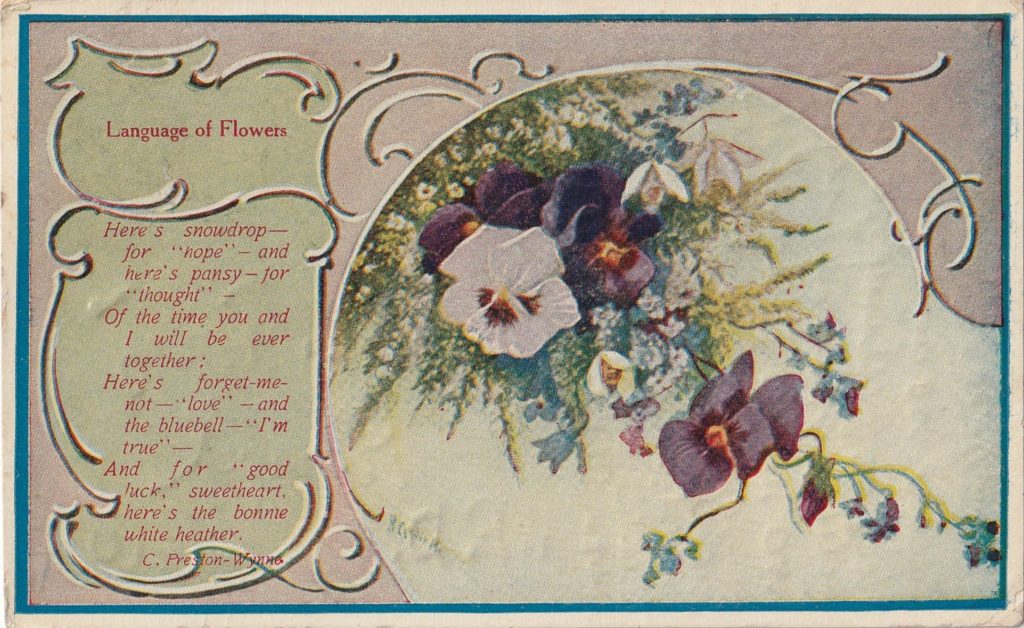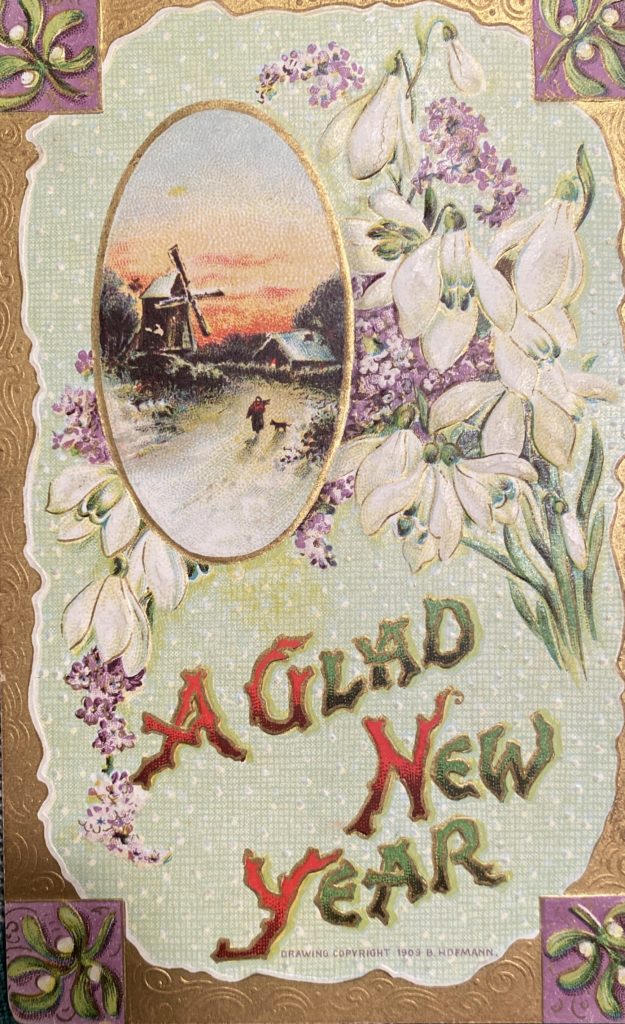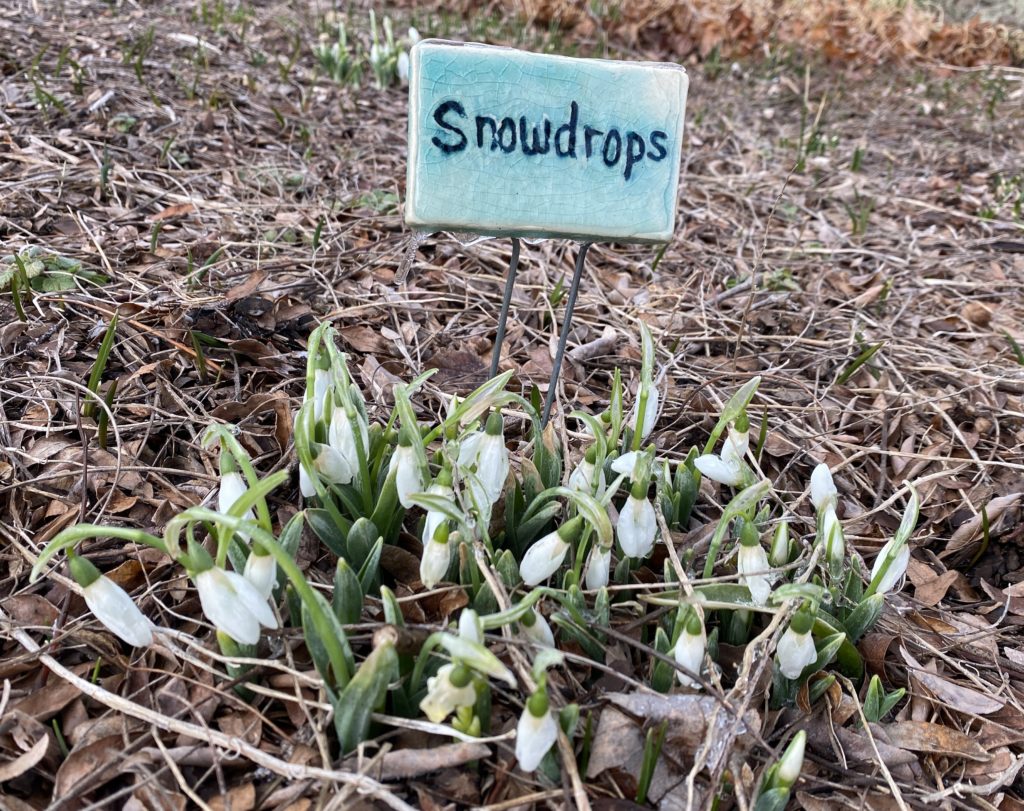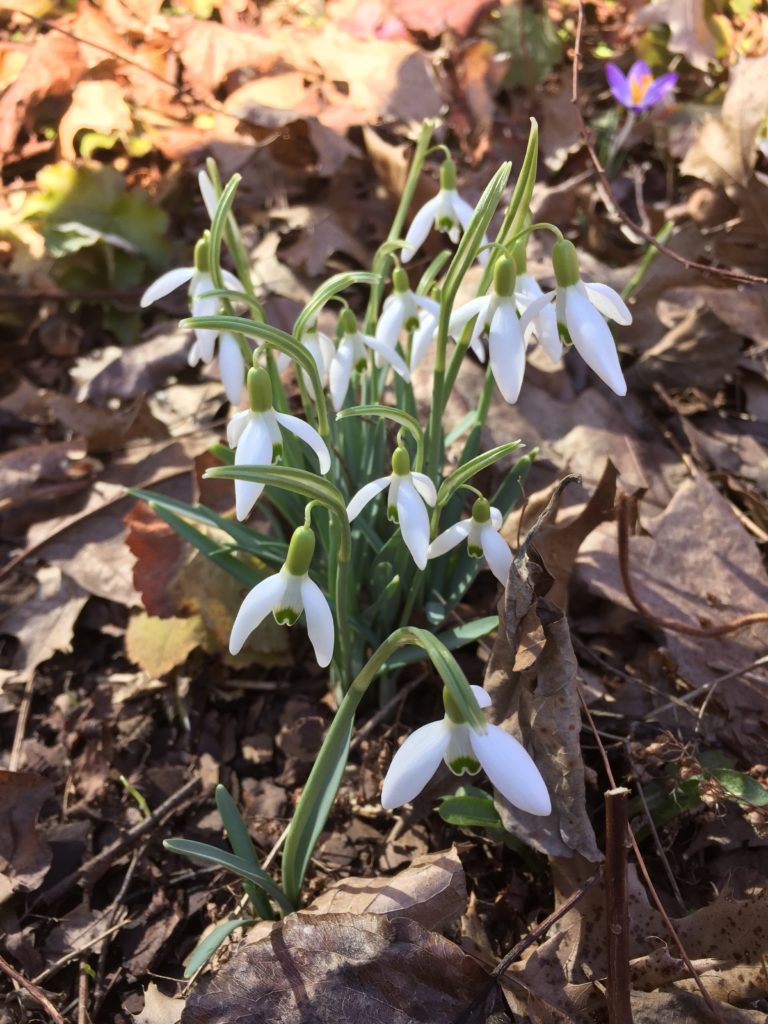
“Here’s a snowdrop—for “hope”—and here’s pansy—for thought”—
C. Preston-Wynne
While looking through a stack of vintage postcards for images of violets and pansies, I ran across this one which also featured snowdrops, and a few other flowers.
Then I found this postcard featuring a New Year’s greeting and snowdrops.

I’ll take this as evidence that snowdrops, back in the day, were considered a flower of the holidays, including Christmas.
Since they are most often found blooming in February or later, I assume that they were once forced into bloom for Christmas and New Year’s Day.
But I couldn’t find much information on how they were forced until I found a lovely book, Bulbs and Bulb Culture: Being Descriptions Both Historical and Botanical of the Principal Bulbs and Bulbous Plants Grown in This Country and Their Chief Varieties with Full and Practical Instructions for Their Cultivation Both In and Out of Doors By David Taylor Fish, 1877.
His first chapter after the introduction is about snowdrops which he says are the easiest of all bulbs to grow.
Shall we see how Mr. Fish suggests we force snowdrops into early bloom?
He clearly advocates for forcing snowdrops.
“In addition to the places already indicated for the growth of snowdrops, they should find their way into window boxes, vases, pans, & on balconies, large and raised vases, tree stumps, and hanging baskets out of doors and in. With the aid of pot culture and artificial heat, the Fair Maid of February may be made to unveil her pale and beautiful face in December. Snowdrops at Christmas would bring a new pleasure to thousands at that great and only feast of the season to so many. It is thus possible to anticipate the snowdrop season in conservatory window garden and sitting room by a month six weeks or two months.“
But he also notes that snowdrops have a reputation for not being easy to force, and why they were thought to be difficult to grow indoors, and addresses that right upfront.
“It is said that the snowdrop is difficult to force and so it often is with the material at command and the way the process is gone about. Dry bulbs that may have been out of the ground for weeks or months are potted, perhaps watered and placed into heat all of a sudden. Is it any wonder that they do not know what to make of it and either refuse to grow or rot outright? Not seldom too they are placed in a degree of heat abhorrent to the snowdrop. Consider their natural position for a moment and it must be obvious that such treatment is unsuitable.”
Clearly, snowdrops like it a bit on the chilly side and most of us know if we get snowdrop bulbs to plant we should do so right away before they have a chance to dry out.
Then there is the best sentence of the entire chapter.
“The snowdrop must be allured rather than forced into early flowering.”
Pause and consider that for just a bit. I can’t think of anything to add to such a sentence.
Now the instructions…
“Go first of all to one of the finest and earliest clumps within reach in November and remove it bodily into a box pan or pot with some earth adhering and so little root disturbance that it may not know that has got out of its own place.”
In my garden, there isn’t often a little clump visible in November, so I marked a spot where snowdrops are blooming now in late February to alert me where to dig.

Yes, that is a pretty fancy marker. I bought it several years ago at a garden event I attended in Michigan, where I also bought two clumps of snowdrops dug from the Henry Ford estate.
Back to our instructions
“Fill up around the clump with a little soil of the same sort so that the pot may be full of earth. Water the mass and let it stand a day or so to drain. Then move it into the sitting room window or place it on the greenhouse or conservatory shelf in a pit or frame.”
In our modern world, we rarely grow potted plants in plain garden dirt, so I suggest using a good potting mix, one that drains well.
“All the snowdrops require is sufficient water and as much air as possible in mild weather and leave them where placed at first until they flower.”
Keep them well-watered with good airflow.
Now the alluring part.
“But the gain of time is a very variable quantity thus and the pace provokingly slow. It can be hastened by stealth, as it were, in the following manner. The earth at the end of the year, early in the next year is generally a little warmer and of a far more stable temperature than the air. By bettering these natural instructions a little, the roots of the snowdrop may be excited to grow faster than usual. The bottom heat beginning gently may rise from 55deg 60deg. Lest however the snowdrop should fancy it was being forced, the top should be kept as cool as possible —almost and by way of satisifying the roots that all was right— they should be watered with cold water with a flake of snow or a dash of ice in it at times.”
Keep the top cool, the bottom warm, and don’t be afraid to water it with cold, icy water. And never let on to the snowdrops that they are being forced, that they aren’t outside somewhere.
Now some reassurance from the author that all will work out.
“There are advantages in these temporary checks to a hardy plant like the snowdrop. The ability of heat to excite them into growth out of season lies less in its absolute amount than in the contrast it presents to the seasons of lower temperature. Certain it is that this mode of keeping roots warm and the tops cool— and the roots also occasionally— succeeds in forcing the snowdrop into beauty out of season better perhaps than any other method.
And furthermore, the pot of snowdrops doesn’t need to be in a sunny location.
“The flowers also come out quicker and better when the plants are partially shaded. It is a mistake to place right in the sun close to the glass; this hinders, not helps, the growth of the flower stems and the unfolding of their beautiful and pure flowers.”
And another reminder not to let the potted bulbs dry out.
“It should be remembered too that February is a wet season; February “fill-dyke” takes care that the roots of the snowdrops are seldom dry— nor flowers nor foliage either. Hence the importance of overhead sprinkling and a rather humid atmosphere after the plants break ground.
Though it might not be as easy to force snowdrops into bloom—excuse me—allure them into bloom as other bulbs, it seems that once they are flowering, the snowdrops don’t need any more special treatment.
“Though the snowdrop is somewhat difficult to force very early, it will almost any hard treatment after it is in flower.”
In fact, after flowering, if you can dig the ground, I think you can go ahead and replant them outside in the garden.
Here are some of the author’s ideas on how to use your allured snowdrops.
“Forced snowdrops are also admirable for wreaths and bouquets associated with violets. These two flowers with forced lilacs and roses seem to bring all that is purest sweetest best of all seasons into the bleakness and coldness of winter.”
Always the violets!
Finally, Mr. Fish notes that really the best place for snowdrops is outside.
“But of course, the place and power of the snowdrop is in the open air, in field and mead, wood and orchard, old shrubbery and new garden. It is alike at home in all and makes every nook and corner of the garden, whether large or small, new or old, home-like and lovely.”

It’s too late for me to try to force snowdrops into bloom this winter, but I’m marking my calendar to dig a clump next November and try it.
Let me know if you are thinking of doing the same.
Or if you’ve ever successfully forced snowdrops inside into early bloom, will Mr. Fish’s instructions work?


You didn’t say where Mr. Fish did his gardening. That may have a big impact on whether his instructions will work for you. If he can actually see snowdrop clumps emerging in November and you can’t, he’s in a warmer climate. But is he even in this country, or speaking from experience as an English gardener? Still, the premise to think like the plant and to replicate the growing conditions when snowdrops usually bloom is sound. I wonder if Matt Mattus could tell you more about how they forced snowdrops back in the day.
Thank you for sharing your article. It’s very helpful for me.
Hello, I was out messing in the garden in early December, and noticed a clump of snowdrop stems just pushing up out of the ground. I thought, “why not dig a small patch out, pot it up and see what happens” I researched a process for forcing ,and came across your charming post. I put the pot on the back cellar steps, which is the coolest place in the house. I brought it upstairs every week or so and put ice chips on the top of the soil, draining well, and put the pot back on the cellar steps. It now has obvious white buds showing! Im thrilled!
Jean,
I’d love to hear how the snowdrops looked once they opened. Were they healthy-looking blooms? And how long did they last? I’m thinking of trying this to use in our parish church at Christmas. Thanks!